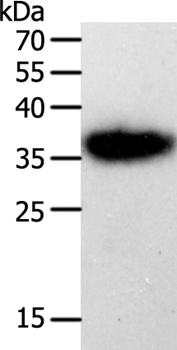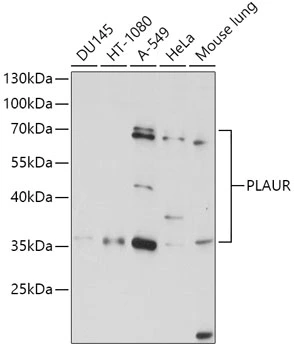uPAR antibody
GTX100467
ApplicationsImmunoFluorescence, Western Blot, ImmunoCytoChemistry, ImmunoHistoChemistry, ImmunoHistoChemistry Paraffin
Product group Antibodies
ReactivityHuman
TargetPLAUR
Overview
- SupplierGeneTex
- Product NameuPAR antibody
- Delivery Days Customer9
- Application Supplier NoteWB: 1:500-1:3000. ICC/IF: 1:100-1:1000. IHC-P: 1:100-1:1000. *Optimal dilutions/concentrations should be determined by the researcher.Not tested in other applications.
- ApplicationsImmunoFluorescence, Western Blot, ImmunoCytoChemistry, ImmunoHistoChemistry, ImmunoHistoChemistry Paraffin
- CertificationResearch Use Only
- ClonalityPolyclonal
- Concentration0.57 mg/ml
- ConjugateUnconjugated
- Gene ID5329
- Target namePLAUR
- Target descriptionplasminogen activator, urokinase receptor
- Target synonymsCD87, U-PAR, UPAR, URKR, urokinase plasminogen activator surface receptor, monocyte activation antigen Mo3, u-plasminogen activator receptor form 2, urokinase-type plasminogen activator (uPA) receptor
- HostRabbit
- IsotypeIgG
- Protein IDQ03405
- Protein NameUrokinase plasminogen activator surface receptor
- Scientific DescriptionThis gene encodes the receptor for urokinase plasminogen activator and, given its role in localizing and promoting plasmin formation, likely influences many normal and pathological processes related to cell-surface plasminogen activation and localized degradation of the extracellular matrix. It binds both the proprotein and mature forms of urokinase plasminogen activator and permits the activation of the receptor-bound pro-enzyme by plasmin. The protein lacks transmembrane or cytoplasmic domains and may be anchored to the plasma membrane by a glycosyl-phosphatidylinositol (GPI) moiety following cleavage of the nascent polypeptide near its carboxy-terminus. However, a soluble protein is also produced in some cell types. Alternative splicing results in multiple transcript variants encoding different isoforms. The proprotein experiences several post-translational cleavage reactions that have not yet been fully defined. [provided by RefSeq]
- ReactivityHuman
- Storage Instruction-20°C or -80°C,2°C to 8°C
- UNSPSC12352203
References
- Lawaetz M, Christensen A, Juhl K, et al. Diagnostic Value of Preoperative uPAR-PET/CT in Regional Lymph Node Staging of Oral and Oropharyngeal Squamous Cell Carcinoma: A Prospective Phase II Trial. Diagnostics (Basel). 2023,13(21). doi: 10.3390/diagnostics13213303Read this paper
- Cardile A, Passarini C, Zanrè V, et al. Hyperforin Enhances Heme Oxygenase-1 Expression Triggering Lipid Peroxidation in BRAF-Mutated Melanoma Cells and Hampers the Expression of Pro-Metastatic Markers. Antioxidants (Basel). 2023,12(7). doi: 10.3390/antiox12071369Read this paper
- Lawaetz M, Christensen A, Juhl K, et al. Potential of uPAR, αvβ6 Integrin, and Tissue Factor as Targets for Molecular Imaging of Oral Squamous Cell Carcinoma: Evaluation of Nine Targets in Primary Tumors and Metastases by Immunohistochemistry. Int J Mol Sci. 2023,24(4). doi: 10.3390/ijms24043853Read this paper
- De Tomi E, Campagnari R, Orlandi E, et al. Upregulation of miR-34a-5p, miR-20a-3p and miR-29a-3p by Onconase in A375 Melanoma Cells Correlates with the Downregulation of Specific Onco-Proteins. Int J Mol Sci. 2022,23(3). doi: 10.3390/ijms23031647Read this paper
- Chang MC, Chang HH, Hsieh WC, et al. Effects of transforming growth factor-β1 on plasminogen activation in stem cells from the apical papilla: role of activating receptor-like kinase 5/Smad2 and mitogen-activated protein kinase kinase (MEK)/extracellular signal-regulated kinase (ERK) signalling. Int Endod J. 2020,53(5):647-659. doi: 10.1111/iej.13266Read this paper
- Chang MC, Chang HH, Lin PS, et al. Effects of TGF-β1 on plasminogen activation in human dental pulp cells: Role of ALK5/Smad2, TAK1 and MEK/ERK signalling. J Tissue Eng Regen Med. 2018,12(4):854-863. doi: 10.1002/term.2339Read this paper
- Tsai YL, Zhang Y, Tseng CC, et al. Characterization and mechanism of stress-induced translocation of 78-kilodalton glucose-regulated protein (GRP78) to the cell surface. J Biol Chem. 2015,290(13):8049-64. doi: 10.1074/jbc.M114.618736Read this paper



![FACS analysis of human peripheral blood using GTX00512 uPAR antibody [VIM5].](https://www.genetex.com/upload/website/prouct_img/normal/GTX00512/GTX00512_20191025_AP_006_49_w_23053121_721.webp)
